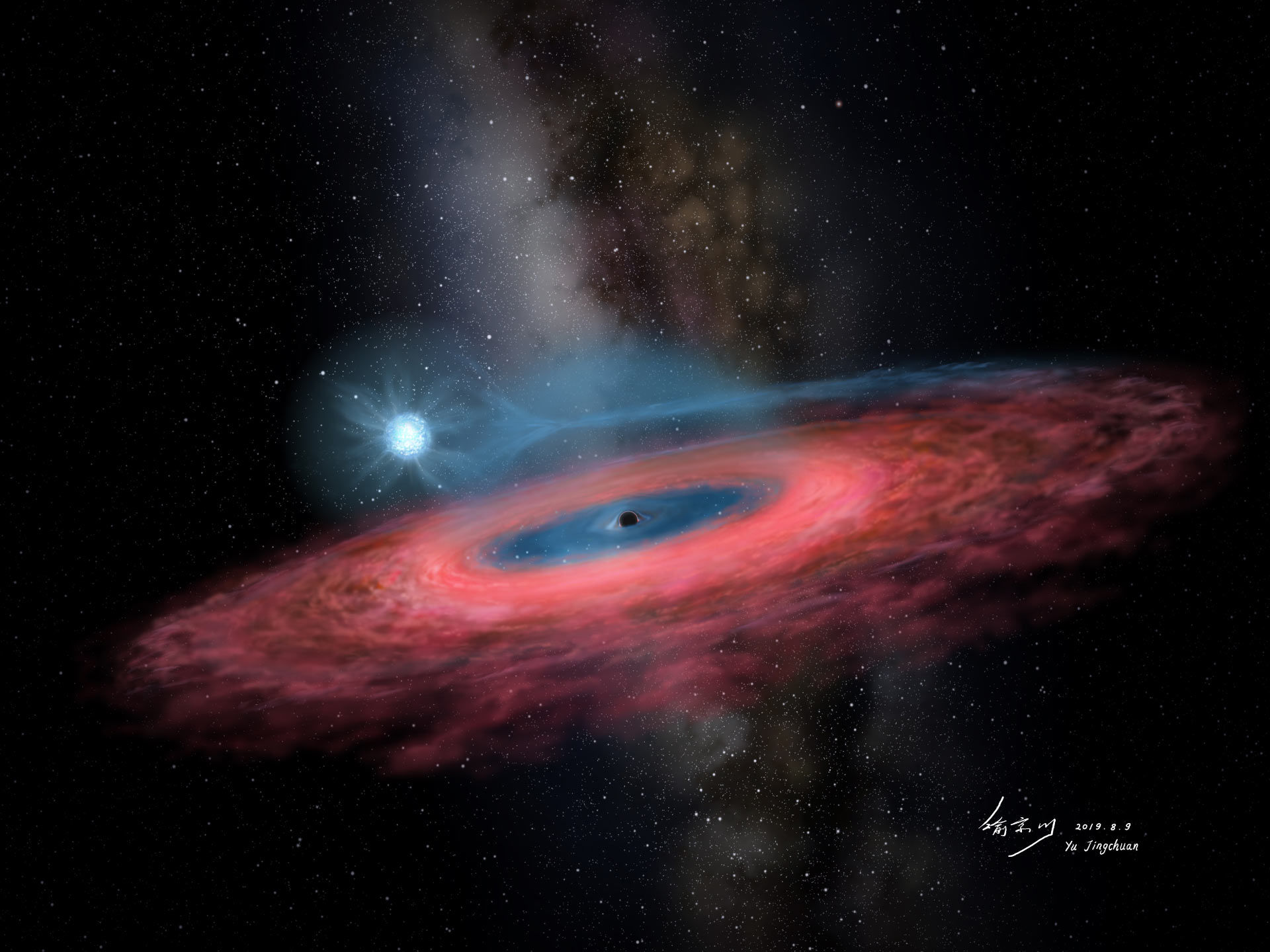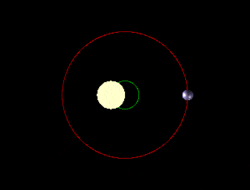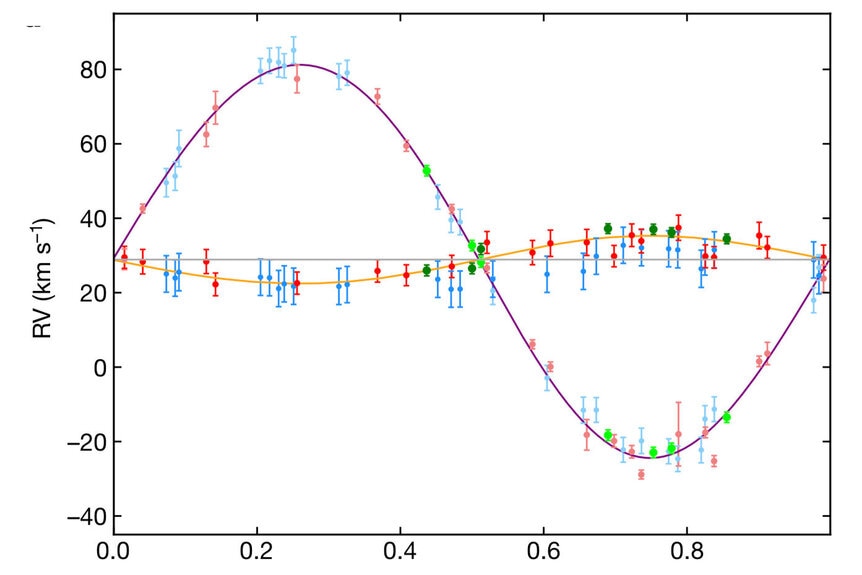Create a free profile to get unlimited access to exclusive videos, sweepstakes, and more!
Q: How did this black hole get so big? A: Maybe it's really two black holes.

Astronomers have found a black hole in our galaxy that’s a lot bigger than we thought this kind could get: It has about 70 times the mass of the Sun, and models of how a black hole like this can form have trouble producing one this beefy.
To be clear, this is what we call a stellar-mass black hole, one with a few or a few dozen times the mass of the Sun. There’s a whole 'nuther kind, called supermassive black holes, with millions or billions of times the Sun’s mass, but those formed in a very different way. Stellar mass black holes form when a massive star explodes; the outer layers blast away in a supernova, while the core of the star collapses into a black hole. It takes a very massive star to do this, something like 25 or more times the mass of the Sun, and those are relatively rare. Still, there are likely millions of black holes like this in our galaxy alone.
The problem is finding them. If another star happens to be in a close orbit around one, the black hole will draw off matter from the star, and this matter will get incredibly hot and emit X-rays. We’ve found a few galactic black holes this way, but not very many. Most are probably either alone in space, and dark, or orbiting another star too far to draw material off it.
While those would be dark as well, they can reveal themselves through their gravity: The other star would orbit the black hole, and we can detect that orbital motion. Not directly; that back and forth motion would be incredibly small on the sky. But we can look at the light from the star, examining it for a periodic Doppler shift. As the star orbits the black hole, for half the orbit it’s moving towards Earth, and it’s light will be blueshifted, and for the other half it moves away from us and its light is redshifted.
In this case, astronomers surveyed stars using the Large Aperture Multi-Object Spectroscopic Telescope which can look at thousands of stars and take their spectra, breaking the light up into thousands of individual colors, to look for that Doppler shift. While examining stars in one part of the sky, they found a winner: A star they named LB-1, a blue star about 14,000 light years away. A lot of info about the star can be found from the spectrum, and they determined it has a mass about 8 times that of the Sun, and that it’s about 35 million years old (so very young; the Sun is 4.6 billion years old).
They also saw a strong and obvious Doppler shift in the spectrum. That shift indicates it’s in a 79-day orbit around an unseen companion. The mass of that second object is a little tricky to determine from the spectrum. The speed the blue star is orbiting is only a minimum speed, assuming we see the orbit edge-on. If it’s actually tilted that speed is higher, and the mass of the second object higher. If the orbit is indeed edge-on, the second object has a mass of about six times the Sun’s… and that’s already good evidence it’s a black hole! A normal star that massive would be obvious in the data, but no such evidence is seen. That means the object must be massive and dark.
As it happens, a fortunate circumstance is that they saw evidence for warm hydrogen gas in the spectrum as well. That gas has a similar Doppler shift, but is opposite the star's shift: When the star is approaching us the gas is moving away, and vice versa. That means the gas is orbiting the second object! Because they orbit each other, when one object is moving toward us the other must be moving away, and (again) vice-versa. The spectrum of that gas indicates the black hole has a mass of about 68 times the mass of the Sun (with an uncertainty of ±11/13, so maybe as little as roughly 50 and as much as 80).
And that’s the problem! When a star explodes, the mass of the black hole left behind can be as little as 5 times the mass of the Sun, and maybe as much as 30. Anything more than that is really hard to achieve. This black hole is more than twice that, so clearly more is going on.
The astronomers posit that perhaps this was originally a triple-star system, where two pretty massive stars orbited other, and the blue star was the third, farther out. One of the two high-mass stars exploded as a supernova, leaving behind a normal black hole. That black hole could've merged with the other massive star, where it would have fallen to the star's core and grown larger. Eventually that star exploded, leaving behind the massive black hole. Or — and this is really cool — it may be that the first massive star exploded to form a black hole, and then the second massive star exploded as well, leaving behind two roughly 35 solar-mass black holes in tight orbit around one another. So instead of being one way-too-massive black hole that's hard to explain, there are two normal mass ones there, and we just can't tell the difference.
[Note (added 2 Dec. 2019): After putting a link to this post on Twitter, @randomsasha noted another paper posted to the arXiv that makes the claim that this can't be a binary black hole; the two black holes would merge in a time that's much shorter than the age of the blue star. They also note the orbit of the blue star around the black hole is very circular, which poses many problems for a past merger of two black holes as well. That makes sense to me, but note that the idea of this being a binary black hole is posited as one way to understand the large mass; it doesn't change the observations that it has a large mass in the first place. If this new paper is correct it means astronomers will have to look for another solution to this enigma.]
Up until now, it’s been thought that you need very special circumstances to get black holes near this mass limit. For example, the abundance of certain heavy elements in stars changes how massive they can get without exploding, and you need a very low abundance to get a star massive enough to create a black hole this big. But the blue star in the system clearly has a high abundance of these elements; if it formed with the progenitor star of the black hole then both should’ve had a high abundance, and therefore should form a low mass black hole. This puts more weight into the idea that this was originally a triple system.
So this is pretty interesting… but there’s more. The LIGO/Virgo gravitational wave observatories detect the ripples made in spacetime when two black holes merge. They've found quite a few so far, and many of them have masses way up near the upper limit of how we think black holes can form by themselves. This has been a problem, since we haven’t seen any systems of binary black holes like that in our own galaxy. But the black hole — or black holes — LB-1 is orbiting may be in this "forbidden zone," showing they do exist in our galaxy.
And mind you, this survey that found it didn’t look at all that many stars. That implies systems like this may be more common than we thought. If true, more observations like this should reveal more of those systems. If that happens, well, astronomers will have a picnic trying to explain them all. Nothing is more fun that having lots of data on objects you thought might be rare, and then having to come up with an idea to explain them all.
Surveys like this were really hard to do until pretty recently, so we’re just getting started with them. I expect it won’t be long before we find more systems like this. That’ll be exciting! Black holes are full of surprises, and this shows they have far from run out of ways to spring them on us.

















